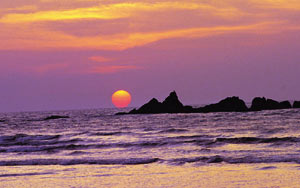|
|
Indianvisit offers complete travel information on Kannur including the facts on Kannur, climate of Kannur, and history of Kannur
|
|
Kannur
 Surrounded by Western Ghats to the east, Kozhikode and Wayanad districts to the south, Lakshadweep Sea to the west and Kasargod to the north, Kannur was an erstwhile port on the Arabian Sea. Popularly known as the city of Looms and Lores, Kannur is famous for Theyyam - the famous performing art of Kannur and beautiful virgin beaches and the handlooms.
Surrounded by Western Ghats to the east, Kozhikode and Wayanad districts to the south, Lakshadweep Sea to the west and Kasargod to the north, Kannur was an erstwhile port on the Arabian Sea. Popularly known as the city of Looms and Lores, Kannur is famous for Theyyam - the famous performing art of Kannur and beautiful virgin beaches and the handlooms.
The name of Kannur has several connotations. Some believe that it might have derived from a village called Kannathur around which developed the modern town of Kannur. Some are of the opinion that it has been derived as a combination of Kannan (Lord Krishna), a god in the Hindu pantheon and Ur which means an abode. The advent of the Europeans was instrumental in molding the name to Cannanore.
History of Kannur:
It had trade relations with Persia and Arabia in the twelfth and thirteenth centuries and was the British military headquarters on India�s west coast up to 1887. Going by the earlier portion of history, the Cheras of Tamil Nadu had established total control over the entire area under Raja Kulashekhara Varman by early 9th century. However, the empire barely lasted till 1102 AD when another dynasty of the Mooshika Rajas. By the 14th century, these kings established themselves as the Kolathiris. The kingdom of the Samuthiris or Zamorins of Calicut in the South was, had continuous feuds for centuries with the Kolathiris.
It was the Zamorin of Calicut who greeted the Portuguese team led by Vasco da Gama in 1498 - the first European to land in India via sea route. Vasco De Gama exploited the rivalries between Kolathiris and Zamorins managed to get almost a monopoly over the spice trade from India. Almost immediately after, Francisco De Almedia arrived from Portugal to put up fortifications at strategic locations. One such fort was constructed at Kannur and named Fort St Angelo, which retains its remarkable shape till date.
However, the Kolathiris and Zamorin united against the Portuguese in 1558. But their victories were not sufficient to eradicate the dominance of the Europeans in India. Soon the Dutch followed and wiped the Portuguese out of Kannur Fort St Angelo. By 1663 the Portuguese power saw its decline.
The English East India Company made its presence felt in this district towards late 17th century, when the Thalassery Fort was constructed. By the 18th century they almost got the lucrative spices trade in total control.
The defeat of Tippu Sultan by the British at Srirangapatanam in 1792 made the entire province surrender to the British. The British divided the province into two administrative sections - one with Headquarters at Thalassery and another at Cherpulassery, under the control of the Chief magistrate at Calicut.
Although the Brtish had brought some amount of political stability to the region, the unpopular revenue policy of the British prompted the revolt by a local Raja - Pazhasi Raja in 1796. The revolt however failed because of the greater British military strength. On the 30th of November, 1805, the British Commander Baber and his team shot Pazhasi Raja dead. With the death of Pazhasi raja, the struggle came to an end in Kerala.
Cannanore played an eminent role in the freedom struggle against the British a century later. The Salt Satyagraha of Mahatma Gandhi found followers at Payyannur. Kannur also was the area from which the Communist movement in Kerala really got going under AK Gopalan. This movement would finally end in Kerala electing the first communist Government anywhere in the world. Even today, Kannur remains a place ruled mainly by the Communists.
Log on to www.touristplacesinindia.com which gives online information on the Kannur on your tour to India.
Next
|